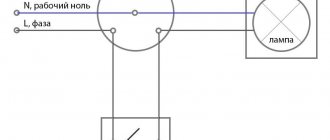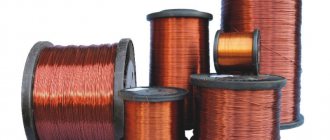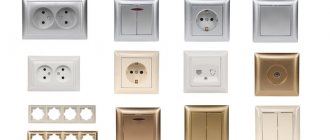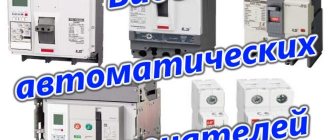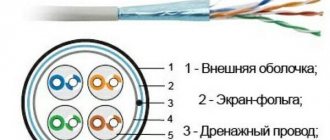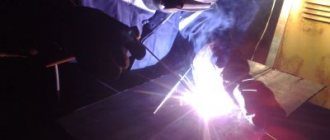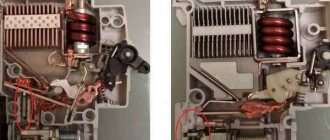The buyer develops his own preference for any product over time. Reviews, recommendations and advice from friends, the Internet and the zombie box play a significant role here. When we come to the store, we already know approximately what brand we need. If it is not there, then we are looking for the next one in our personal ranking. Finally, we use tips from sales consultants.
It's the same with electrics. When faced with this area for the first time, an unprepared person may be confused, to put it mildly. I'm not talking about banal Ilyich light bulbs or extension cords for the refrigerator. Although their range also goes beyond reasonable limits. And take at least a more specific product - the same automation. It is not easy for the average buyer to immediately navigate the multitude of companies and manufacturers. Some begin to remember what they have heard before in the electrical field or seen from friends, others consult their friend, the electrician Uncle Vasya. After all, experienced installers usually already know which manufacturers are trustworthy and which ones should be guarded like fire.
Let's look at a simple example. You have decided to modernize the automation on your line, simply move the panel into your apartment, or finally switch from traffic jams to automatic machines. It's a good thing. Electricians came to the store to buy automatic machines on Uncle Vasya’s advice. Scientifically, they are also called circuit breakers. In a large retail outlet there is about two dozen assortment of them. A reasonable question immediately arises: what to choose? There are cheap and expensive, small and large, beautiful and nondescript, light and heavy, Chinese and European on sale. Let's look together and figure out what smart Vasily wrote on the piece of paper.
Say a word for the poor Chinese - IEK, EKF, TDM.
It is clear that Legrand, Huger and ABB are great. But much more in the vastness of the Motherland is offered of all sorts of IEK, EKF, TDM, and other products of our successors in the work of building communism. I ask forum members to share which of these and in which category (automatic machines, ouzo, etc.) is better today? Maybe someone has heard something, or maybe they’ve taken it apart or experienced it themselves.
EKF seems to be better, but it doesn’t seem to be quite the same. You can still install all kinds of automatic machines (you’ve splurged on branded ones), but it’s better to take an expensive ouzo.
. especially if the legrand is Chinese.
It’s better for yourself not to experiment whether it will work or not. Schneider’s “brownie” series seems to be not expensive and of quite high quality. If you have somewhere to look, look at Korean equipment (eg Hyundai). The price is average, but the quality is much better than China.
Last edited by arhara; 08/21/2012 at 09:42.
EKF - operating temperature failure. RCDs with an operating temperature of up to -5 (according to the passport!) are not suitable for use in our area. In general, do not forget to carefully look at this parameter: most panel electrical equipment is now made at -25, but there are exceptions in both directions.
IEK - no complaints. Illiterate electricians cause many more problems.
We also take into account that two-stage differential protection on cheap components will have a reliability many orders of magnitude higher than one stage on the most expensive one. RAID, Redundant Array of Inexensive Disks in servers was invented many years ago precisely on this idea of multiplying small failure probabilities. 0.001 * 0.001 = 0.000001.
uh? I have all the shields indoors. What kind of -25?
The EKF diffs work as they should. The topic has already worked 3 times. You can choose a brand in our village only for automatic machines, for ouzo/diff - it’s good if you find the right denomination (I never found a mechanical diff for 10 ma. I had difficulty finding an udzo for 10 ma, the traders stubbornly tried to sell an electronic one for 30 ma - that’s all they take it and don’t complain), not to mention the brand. and in terms of the ekf and iek machines sold by sellers, they are indistinguishable.
And we have complaints about the IEC, though not about the machines, but about the starters - frequent sticking. As a result, they were abandoned when assembling the shields. We didn’t see any problems with the machines, but the same hands make them, so I didn’t use them for myself.
And who can tell me about TDM (“Morozov’s company” - in fact, of course, China, according to rumors, it was founded by a person who previously worked at IEK) More specifically, I’m interested in differential automatic machines like this https://www.necm.ru/product/modular_equipment /199/ The price of the differentials is very attractive given the stated characteristics. Who installed these? I also heard that TDM machines are better than IEK and “do not creep apart” when screwing in the contact screws because there are more rivets in them.
Air input? If so, then what about the mandatory shield at the input that protects the cable from the gable to the meter? At a minimum, there must be a circuit breaker, and in the case of a TT circuit, a fire protection RCD. On the street.
I've never seen one in the neighborhood. Can you provide the points of binding documents? Only in photos on the Internet and at the impudent demand of network and sales companies to make meters on the street. Everywhere it is connected from the gander directly into the house to the meter. By the way, a box with a machine gun on the street and another one with a meter in the house is an electricity thief’s dream.
eh. I'll start the story. 1. my input is underground 2. when connecting, the network required a megafinder meter on the pole. but then she refused, because I gave her 3 objections: a) the meter is on a pole, I don’t control the pole, and if something happens to it, it will be a network problem. b) the meter is not on sale. The manufacturer does not work with individuals, does not work with legal entities, but only with network companies. The network offered to buy a meter for me. c) the meter is located on a pole, how to read the readings for payment? 3. a friend connected a WOODEN FRAME. At first they also wanted it on a pole, then they refused. The network didn’t even mention the machine on the front. I convinced a friend to install it, since the house is wooden. You can buy one machine that is frost-resistant. The machine was taken with the possibility of sealing. but AFAIK the network didn’t seal it.
Day one: ITK
The IEK GROUP company produces products under several brands, I will tell you about some during the course of this article. On the first day, right after a night on the train, I went to the exhibition stand of ITK products (IEK GROUP brand).
Sergey Panagushin, Anton Timofeev, me and Tatyana (IEK) at the ITK exhibition
ITK showed its products (signaling, low-current networks and systems, etc.) as part of the Securika exhibition at Crocus Expo.
Author of the SamElectric.ru blog at the IEK ITK exhibition
To be honest, I wasn’t particularly interested in the product. Although I had a lot to do with such things.
The ITK robot caught my attention. I don’t know if it’s an exoskeleton or a stylization of it, but it’s impressive:
The employee walked around the stand all day and mowed under the robot, attracting the attention of visitors.
All cabinets are made in Russia (I’ll tell you about them in the description of day 3).
Apartment low current cabinet with router
Regarding the router, I never received a clear answer - how does it work and transmit the signal if the cabinet is metal, and there will be a weakening of the signal? Probably the secret is in the external antenna.
In my reinforced concrete apartment, a router operating at full capacity did not “finish off” from one end of the apartment to the other, I had to move it to the center of the apartment.
By the way, I have an article on Zen about the dangers of Wi-Fi radiation. At the end of the article, designs for tin foil hats are given.
Automatic machines for home wiring: which ones to choose?
The buyer develops his own preference for any product over time. Reviews, recommendations and advice from friends, the Internet and the zombie box play a significant role here. When we come to the store, we already know approximately what brand we need. If it is not there, then we are looking for the next one in our personal ranking. Finally, we use tips from sales consultants.
It's the same with electrics. When faced with this area for the first time, an unprepared person may be confused, to put it mildly. I'm not talking about banal Ilyich light bulbs or extension cords for the refrigerator. Although their range also goes beyond reasonable limits. And take at least a more specific product - the same automation. It is not easy for the average buyer to immediately navigate the multitude of companies and manufacturers. Some begin to remember what they have heard before in the electrical field or seen from friends, others consult their friend, the electrician Uncle Vasya. After all, experienced installers usually already know which manufacturers are trustworthy and which ones should be guarded like fire.
Let's look at a simple example. You have decided to modernize the automation on your line, simply move the panel into your apartment, or finally switch from traffic jams to automatic machines. It's a good thing. Electricians came to the store to buy automatic machines on Uncle Vasya’s advice. Scientifically, they are also called circuit breakers. In a large retail outlet there is about two dozen assortment of them. A reasonable question immediately arises: what to choose? There are cheap and expensive, small and large, beautiful and nondescript, light and heavy, Chinese and European on sale. Let's look together and figure out what smart Vasily wrote on the piece of paper.
Vending machines for apartments
For apartment wiring you need: two-pole input and single-pole distribution machines. The two-pole one is placed at the input in front of the counter. As a rule, a rating of 32 A or 40 A is taken. It all depends on what kind of input cable it is.
If you refer to the Electrical Installation Rules, and specifically to clause 1.3.6, you can see that a cable with a cross-section of 4 mm2. holds 38 A, cross section 6 mm2. - 50 A. This is true for the so-called GOST cables, i.e. those whose cross-section corresponds to the declared ones. I wrote about them in the article Cable for home wiring - which one to choose?
We select the machine with the closest denomination in the decreasing direction. Not 38 or 50, but 32 A for four, and 40 A for six.
Single-pole circuit breakers with a nominal value of 16 A are installed for lighting. The cable is taken with a cross section of 1.5 mm2. Holds 19 A. 25 A machines go to the socket group. The cable is taken with a cross-section of 2.5 mm2. It holds 27 A. But everything again depends on the cross-section of the wire. The main purpose of the machine is to protect the cable.
There is also such a parameter as short circuit current. Automatic machines with a capacity of 4500 A (4.5 kA) are suitable for an apartment. In the residential sector, the line resistance from the substation to the short circuit is such that the short circuit current will be within 4.5 kA. If you buy 6kA it won’t be worse, but they cost more.
Which manufacturers are better?
The next question is: Whose production should we take? Cheap ones are usually from China. There is a wide choice of them: TDM, Energy, IEK, EKF, Dekraft, Chint. The cost of a single-pole one is around 100-130 rubles.
KEAZ may have an average price tag: VM 63 series. This is a good price/quality ratio. Moeller and Hager are European manufacturers with a price tag below premium.
The premium segment is Schneider Electric, ABB and Legrand.
Over ten years of working in the electrical trade, I, like Uncle Vasya, have formed my own rating for automatic machines. Let me say briefly, if you are buying for your own home, then ABB would be the best option. I recommend this brand to all my friends.
Which machines to choose: IEK or ABB?
We also focus on AB class devices: due to their reasonable price, they are most often installed at home. The article ends with a short TOP based on the quality of circuit breakers from various manufacturers.
How to calculate the required nominal value of the machine
The choice of machine depending on the load current, wire/cable cross-section and installation method is determined by GOST and PEU.
For example, let's take a 3 kW stove. The house has a single-phase 220 V network. We need to calculate the current strength (A). To do this, divide the power (W) by voltage (V). We find that the current strength is 13.64 A.
The cable required is 1.5 sq. mm. It can withstand 19 A. In this case, we take the machine of the nearest lower denomination, i.e. 16 A. It will protect the cable if 19 A is exceeded. The consumer current is less than the rating of the machine. Therefore, the machine will not turn off.
Select characteristic: B or C. B - take if there are no starting currents: lighting, heating devices; choose C if there are small starting currents - refrigerator, vacuum cleaner, all appliances with motors. In our case, B will do.
The main rule when selecting a machine is that the wire or cable can withstand the total load of all consumers connected to it. Then, according to the cross-section of the conductor, select a machine that will protect it from overload.
If the consumer’s power exceeds the capabilities of the cable, then the machine still needs to be taken under the cable, not under the load. When selected for load, the machine will not operate, there will be no proper protection for the cable and it will heat up. In this case, it is better to consider the option of replacing the conductor with a larger cross-section.
Day three: production
Most of IEK GROUP's products are manufactured in China. But how much can you justify and apologize for this fact? It’s time to look at the facts and admit that Russia has failed the import substitution program, and the Chinese have overtaken the entire planet not only in terms of mass production, but also in technology and product quality. And the price/quality ratio can be anything, depending on the client’s desires and marketing plans.
The production of metal trays, cable ducts, corrugations, cable couplings, metal and plastic cabinets (including ITK, which I talked about at the beginning of the article) is located in Yasnogorsk, Tula region.
By the way, even in Russia, in Skolkovo, a modular Arc Failure Protection Device UZDP IEK is produced, which I wrote about a couple of years ago.
Profile and trays
Trays are made from metal sheets of different thicknesses.
Production is fully automated.
Watch a video of how a metal tray (cable support system) is made. The process is continuous, the tray is endless, the knife follows the tray, cutting as it moves. By the way, corrugated fabric is cut in approximately the same way when producing cardboard boxes.
Samples are taken from each batch for strength testing:
The perforated profile is overloaded on a special stand
Metal cutting machine
A cutting-coordinate machine cuts out cabinet parts from a sheet of metal:
The same is on video:
Bending and welding
Next, press brakes and robots come into play, folding and welding the boxes from metal blanks.
The most responsible operations are, of course, performed by people:
Welder in the production of IEK cabinets. Photo by Alexey Bartosh
The grounding bolt is zeroed using welding in an instant.
Shooting of studs at the production of electrical panels IEK. Plastic is screwed onto the front panel through these studs. Photo by Alexey Bartosh.
After shooting with sparks, you get this neat hairpin:
Before painting, a cap is put on it so as not to paint over the thread.
By the way, some of our colleagues (in the list above) made a rational proposal that improves electrical safety: change the design of the cap so that not only the thread, but also the area around the pin with a diameter of about 10 mm is not painted over. This unpainted surface will provide better ground contact than the thread.
Painting shop
Finished boxes arrive at the painting line:
Sealed doors
Gluing strips of rubber sealing on doors to ensure that the electrical panel can operate in any weather is a thing of the past. Now this is done by a robot that applies a polyurethane mixture. The polyurethane hardens and becomes a durable material.
Process on video:
By the way, the soles for our sneakers and boots are made from such polyurethane. I once worked at a shoe factory, and even went to Germany to study this business)
Door installation
Final assembly and packaging is done manually, since there are about a hundred types of cabinets, and reconfiguring the assembly line would be problematic.
Pneumatic tools are used.
Assembly and packaging of IEK cabinets
PVC workshop
PVC corrugated hose manufacturing workshop. Corrugations of any diameter, after several machines, enter a common conveyor and are packaged:
Production of PVC corrugation IEK
They also produce cable ducts of different sizes and colors, various distribution boxes, couplings, plugs, etc.
HDPE pipe
Workshop for the production of two-layer HDPE pipes, which are used in particularly difficult cable laying conditions:
HDPE pipe IEK. Anxious waiting - a fresh bay emerges
Features of slot machines of some famous brands
1. TDM. Country of origin: China. They are making two episodes. BA 47-29 can be connected with a comb and has side notches for cooling. Short circuit current (SC) - 4.5 kA. Conveniently, these machines can be sealed using special plugs. True, they are sold separately. Unlike KEAZ and Decraft, which have them included. The first one is scattered in a box, the second one is in the form of a cap on each product.
The second series 47-63 without comb connection and no notches. Short circuit current 4.5 kA.
The price for these machines is one of the most affordable. On average 130 rubles.
2. Energy (China) . There are also two series being released. VA 47-29, the comb is placed on both sides, there are side recesses, a power indicator, the short-circuit current is already 6 kA.
The second series is VA 47-63. It also has a short-circuit current of 6 kA, but there are no recesses or an indicator.
3. IEK (China) . One of the most popular slot machines. Most buyers have heard of them. Therefore, they often ask and give preference to this brand. Episode 47-29. Current 4.5 kA, comb on both sides. There are side recesses.
4. Decraft . Made in China. It is distinguished by the presence of stickers for different groups: kitchen, rooms, bathroom, corridor, children's room, etc.
5. EKF . The main feature is that the Proxima series includes plugs for sealing. They do not need to be inserted into grooves like TDM, KEAZ or IEK. They are made in the form of a hinged lid. Keep in mind that the cheap 47-63 series does not have them.
6. KEAZ . The abbreviation stands for Kursk Electromechanical Plant. Produces two series of household machines. VM 63 is made in Kursk. It comes with a comb and sealing, seals are included, there is a contact indication, they are designed for a current of 6 kA.
VA 47-29 is a cheap Chinese version. Does not fit the comb, no indicator, current 4.5 kA, not sealed.
7. GE (Hungary) . Space for the comb on one side, starting with single-pole ones. Current 6kA, no side recesses. They look solid and weigh noticeably.
8. Moeller . Produced in Austria and Serbia. Suitable for those who don't like everything Chinese.
9. Eaton . Just a series of slot machines from Moeller. Produced in Europe.
10. Shneider Electric . These machines are green. Several series are being produced.
The first Acty 9 - no recesses, indication or comb. Manufactured in Thailand and Bulgaria. C 25 A Bulgaria, below Thailand.
The Easy 9 series is very popular. It is inexpensive. Single-pole ones cost 150 - 180 rubles.
11. Legrand TX (Poland). Current 6000 A, there are recesses, no comb and indicator. Alternative to Schneider.
12. ABB (Germany) . Those who value quality choose ABB or, in our opinion, simply ABB. Cool electricians and electrical panel assemblers love this brand for its reliability and affordability. These machines are still made in Germany. The Germans also produce two series:
S - 6000 A, recesses, indicator, comb on one side. Price about 200-300 rubles.
SH - 4500 A, recessed, no indicator and comb. Price about 150-250 rubles.
Who came to the meeting with IEK GROUP?
For more than 10 years I published articles on my blog, was active on VKontakte and Yandex.Zen, and as a result, life turned out in such a way that I was among the invited respected people. Here they are, with names and regalia, in my subjective opinion:
- Anton Timofeev - best known as the administrator of the largest electrical community “Electric” in VK - https://vk.com/ehlektrik,
- Valery Cherepanov - despite the fact that he does not have his own platform, he is a recognized opinion leader in the electrical communities of VK - in particular, “Electric” and “ETM”,
- Sergey Panagushin – YouTube blogger, channel “Electric Housing and Communal Services Izhevsk”,
- Alexey Bartosh – author of articles on electrical engineering on electrical engineering sites of the Runet, YouTube blogger (channel “ELSTUDY”),
- Maxim Kilmetyev – designer of electrical panels, YouTube blogger (Faraday channel),
- Alexander Vyatkin – YouTube channel and VK community “Team GOST Plus”,
- Nikolay Polyakov – YouTube channel and VK community “Team GOST Plus”,
- Alexander Yaroshenko is the author of the blog SamElectric.ru, who is now writing these lines.
Looks like you didn't miss anyone?
Is it worth changing TDM to IEK?
In the storey cabinet from the developer there is an automatic (50A) and a difavtomat (63A/100mA) TDM. (Sorry, I took photos on slippers).
Should they be replaced with similar IEK ones, or is it just a waste of time?
I think I heard here that EKF and TDM are very bad, but IEK is tolerable.
Is the house guaranteed by the developer? Place whatever you want in the apartment panel, but don’t touch the floor panel.
SunFire wrote: I think I heard out of the blue that EKF and TDM are very bad, but IEK is tolerable.
EKF generally sucks, and there is no point in changing the Morozov trading house to IEK. All three brands are not ice, especially since the developer installed them, even if they change them if necessary.
SunFire, ideally change it to a 2P AB and a selective 100mA RCD - you can at least get one from IEK.
I would change the TDM in my shield right away. I haven't contacted this brand for a long time. If only the faulty ones have to be replaced. but yesterday I came across an interesting test, the result was also not in favor of TDM
I think TDM is of worse quality than IEK. And even worse than the EKF (which is also worse than the IEK).
IMHO, if you change it, it won’t be IEK. Or don't change it at all.
Design, installation supervision, panels
EKF has its own niche, sealable covers + free setpoint adjustment.
Alexey_Spb wrote: IMHO, if you change it, it won’t be IEK. Or don't change it at all.
Well, if finances allow, then it’s possible not to go to IEK, and not changing is also not an option. Although if the shield is at the entrance, you can wait for now.
SunFire, here’s another inexpensive, popular, kraft durch freude
Hellraiser of the 90s, reborn by Schneider and having crossed the 6kA mark, the invincible and legendary DalElectroKomplekt. DEC is dead! Long live DEKraft!
Abrikos wrote: SunFire, here’s another inexpensive, popular, kraft durch freude
Hellraiser of the 90s, reborn by Schneider and having crossed the 6kA mark, the invincible and legendary DalElectroKomplekt. DEC is dead! Long live DEKraft!
Abrikos, Is there a solenoid like on a tank, in dynamic protection?
It would be better if they made his face out of two halves.
There is only one legendary
SunFire wrote: Should they be replaced with similar IEKs?
if the choice is only from IEC, then it’s worth
I don’t like people who are irresponsible and without B/Y. Responsible and with Ch/Y - welcome.
I wonder why the developer installed two automatic machines in a row: regular and differential? Wouldn't it be more logical to install a fire protection RCD instead of the differential?
Starnet122 wrote: I wonder why the developer installed two machines in a row: a regular one and a differential one? Wouldn't it be more logical to install a fire protection RCD instead of the differential?
So that RCBO is a fire protection 100mA. Although I don’t see much point in putting them in high-rise buildings. IMHO.
Starnet122 wrote: I wonder why the developer installed two machines in a row: a regular one and a differential one? Wouldn't it be more logical to install a fire protection RCD instead of the differential?
So that RCBO is a fire protection 100mA. Although I don’t see much point in putting them in high-rise buildings. IMHO.
Songo, yes, it’s clear that 100mA, I’m asking why it was necessary to install a differential, and not an RCD.
Starnet122 wrote: yes, it’s clear that 100mA, I’m asking why it was necessary to install a differential, and not an RCD.
Well, because before the meter they usually install an Automatic or RCBO, and after the meter on the subscriber’s line they also install an Automatic or RCBO, so there are 2 of them. .
Songo wrote: So that RCBO is a fire protection 100mA. Although I don’t see much point in putting them in high-rise buildings.
Yes, yes, the laws of physics are different in high-rise buildings. multi-storey
TOP 8 best RCD manufacturers
The rating includes the best RCD models based on customer reviews and expert opinion.
Which RCD would you choose or recommend?
No. 8. IEK
The Russian company IEK produces its goods in Chinese factories in order to save money. The company's catalog contains more than 4 thousand products, 200 of which are dedicated to circuit breakers. Modular devices are presented in models with eighteen current categories (0.5 - 64A) and 3 characteristics B, C and D. Devices from IEK are liked by professionals due to their recessed contacts and two-color indicator window.
- budget price (models on average cost 2 times less than imported ones);
- precise operation by mechanical and electromagnetic system;
- comfortable narrowed body made of high-quality plastic;
- Easy connection of devices using a shaped screwdriver.
- some models are sold defective and quickly break down;
- During a short circuit, the wires inside the machine may burn.
No. 7. Moeller
The Serbian company Moeller produces a wide range of RCDs: PL4, PL6, PL7 and FAZ. The number corresponds to the power of the circuit breaker - PL4 is among the weakest. The current is limited to 63A. The device is connected to cables with a cross-section of 25mm2. In addition to the standard series, the manufacturer produces a special one - industrial (called PLHT). It passes voltage through 32mm2 cables and supports current up to 125A.
- all products are equipped with a window that notifies when the device is triggered;
- universal connection (switches work with pin and plug buses);
- protective mechanisms are represented by 5 lines;
- FAZ category models allow the breaking capacity to be adjusted.
- increased prices for goods (compared to analogues);
- sometimes there are non-original switches.
No. 6. Chint
All Chint products are made in China. Modular devices are manufactured in several categories: NB1, NBH8, DZ47, DZ158. The NB1 line is available with special accessories. All RCDs are designed by the manufacturer for alternating current no higher than 400 V. The machines are made in a narrow body and have IP20 protection. All products are certified and manufactured in legal factories.
- all response indicators are available;
- emergency contacts can be established;
- modular models are available with poles 1-4;
- the lowest prices for products on the Russian market.
- non-wear-resistant electromagnetic part (up to 4 thousand cycles);
- limited use: switches are not suitable for wires with a cross-section larger than 25m2.
No. 5. KEAZ
The Russian manufacturer KEAZ has been producing electronic devices since 1945. The company's products are sold under two brands: KEAZ and KEAZ Optima. The first brand is focused on the production of classic slot machines, and the second - on the introduction of new technologies. KEAZ is engaged in the manufacture of RCDs for direct and alternating current. Among the switches, the OptiDin BM model stands out, equipped with convenient fasteners on plastic.
- wide selection of extras accessories in the form of releases and handle locks;
- reasonable prices for models from the classic line;
- application of the cascading principle for savings;
- use of a fully selective protection system.
- models from the newest line are sold at an inflated price;
- The service life of standard RCDs does not exceed a couple of years.
No. 4. Siemens
The German company Siemens has worldwide popularity due to its versatility. For protective devices, the developer has provided three series - SY, SJ and SX. The products of the first series are manufactured in Germany, while the second and third series are manufactured in Czech and Romanian factories. The machines are equipped with cable openings with a cross-section of 0.5 – 35mm 2 . The screws that secure the tightening of the clamps have Pozidriv slot heads.
- the device body is completely protected from unintentional touches;
- the slats are securely fixed in the shield;
- easy procedure for installing an RCD and subsequent wiring;
- convenient design that simplifies finger access to the junction box.
- Siemens focuses on household models with a value of no higher than 63 A;
- When fixing screws, a specialized screwdriver is required.
No. 3. Schneider Electric
Schneider Electric has been on the market for over 150 years and is an expert in the field of electrical control. The protective devices are presented in three versions: Easy9, Acti9 and Brownie. The response of the mechanisms is focused on the range from 0.5 to 63A. To protect the user, the clips are recessed into the body of the product. The inlets are cast and equipped with stiffening ribs to protect against thick wires.
- a large number of RCDs in a modular format;
- practical handles - easy to grip with fingers;
- increased product safety.
- switches work only with combined busbars;
- cannot be used in production due to current rating restrictions.
No. 2. Legrand
The French company Legrand produces RCDs in four versions: DRX, DX, RX, TX. The first option is intended for industrial tasks, and the other three are for household ones. The manufacturer produces housings with protection against dust penetration and simplified access to the terminals. A distinctive feature of the Legrand RCD is the empty space on the front panel for applying auxiliary markings during installation.
- the presence of devices that support the highest voltage level;
- switches have fixed settings that adapt to specific conditions (you can change the response speed);
- sophisticated protection against counterfeiting using laser barcode application;
- The developer's products are used in all areas - from household to industrial.
- some models are equipped with uncomfortable toggle switch handles;
- some of the highest prices on the electrical equipment market.
No. 1. ABB
The Swedish developer stands out from other companies with a large range of RCDs. Among the brand's well-known new products is TruOne, which is positioned as the world's first absolute ATS. The devices have a current range from 0.5 to 100 Amps, which corresponds to the characteristics of each building. ABB switches are in demand among both ordinary users and professionals.
RCD categories
RCDs are divided into four categories depending on the control method, purpose, installation method and number of poles. Each RCD has its own scope of application and operation restrictions.
| Type | Characteristic |
| Electromechanical | The oldest type of switch, dating back to the 1920s. The device uses leakage current as an energy source for protection. The main advantages of an electromechanical RCD are durability and precise operation. The magnetic core is characterized by increased sensitivity and constant temperature. The device is made of alloys based on nanocrystals, which have a high level of permeability |
| Electronic | The device is driven by an amplifier on a microcircuit or semiconductor triode. The switch accurately reacts to the appearance of even a small current in the secondary winding area. The amplifier converts the current into a pulse needed to activate the relay. In order for the parts of the electronic RCD to be activated, voltage must be present. The need of devices for mains voltage is the main disadvantage of this type of switch |
| Portable | A simple and compact mechanism that is installed in rooms with high humidity (for example, in the bathroom). The model is a network adapter with a socket-shaped hole for a plug. The device is connected to the outlet, after which the electrical appliance can be turned on. When installing such an RCD, there is no need to change the wiring parameters |
| With overcurrent protection system | A combination device that provides protection to users from electrical currents greater than the rated current. The main advantage of purchasing such a mechanism is its compactness - the device takes up little space in the panel. The device has one vulnerability - it is not protected from false positives caused by office equipment |
Day two: laboratory
The company has its own testing laboratory that checks and tests its products (and not only its own - after all, you need to know what competitors are doing)). By the way, the IEK laboratory is not certified; its test results are only suitable for internal use and have no official force (for example, in court).
The excursion was conducted by the head of the laboratory, Alexander Alexandrovich, a former military pilot. Despite his workload, he explained in detail and showed what and how they test.
The head of the IEK laboratory explains how busy they are with work
Valery Cherepanov and I listen carefully to San Sanych
Laboratory equipment
I once worked in a metrology laboratory, and I see that the equipment is at a high level.
These are not all instruments and test facilities.
Testing Light Sources
Testing lighting products at high voltage. This is how LEDs are checked - after a certain time, the luminous flux should not fall below a certain level.
Autotransformer, 243 V output for powering the luminaires under test
Test samples, says IEK specialist
Compression test
Here they test a corrugated hose for compression:
Corrugation Compression Tester
Workplace of a compression tester laboratory assistant
Corrugated cardboard is tested for strength in the same way. But in another laboratory)
Testing light bulbs for operating time
There is a separate house on the territory - “Light Room”. Light bulbs and spotlights are lit there around the clock, according to the test program.
And since IEK has not yet achieved efficiency = 100% for its products, even in winter it is very hot in this room.
We were also shown a special ball where a light source is suspended to check the emission spectrum. But they were not allowed to photograph him.
Climate chambers
The laboratory has several climate chambers to test the operation of electronics at low and high temperatures and high humidity, and a chamber with water jets to test for IP:
IP Verification Camera
This concludes our excursion...
RCD selection criteria
When choosing an RCD, attention is paid to several main parameters:
- type of release. RCDs that are installed in apartments have 2 types of tripping - A and AC. Type A devices are designed for alternating sinusoidal and constant pulsating current, which appears gradually or increases. AC devices are designed for alternating sinusoidal leakage current that appears suddenly;
- number of poles. The number of poles in the RCD is determined by the voltage in a particular network. The higher the voltage, the more poles the breaker must support. For 220V networks, two-pole models are used, for 330V networks, four-pole;
- protection current. This criterion refers to the current strength passed by the RCD during continuous operation. This indicator is equal to or is a level higher compared to the RCD, which protects the same part of the circuit;
- breaking current. The parameter indicates the leakage current, which is sufficient to trip the circuit breaker. This criterion has a universal value - 30 milliamps. It prevents the threat of fire and is used on lines with increased load;
- shutdown time. The criterion determines the period that separates the moment the leak occurs and the moment the RCD is triggered. According to the standards, the permissible response period is 0.3 seconds. The best switches have increased shutdown speed to 0.02 seconds;
- temperature regime. Standard RCDs are designed to operate at temperatures from -3 to +35 degrees. Manufacturers produce special frost-resistant models that can be used in conditions down to -20 degrees.
Video - What to look for when buying an RCD
When purchasing an RCD, the type of room in which the device is installed is taken into account. Rooms with a lot of moisture require highly sensitive devices that respond to 10 milliamps. For other rooms, 30 milliamp devices are suitable. The price of differential shutdown devices depends on the leakage current and the number of poles.
Criteria for selecting circuit breakers
Figuring out which safety switches you need to purchase is not that difficult. When selecting machines, several aspects are considered:
- number of poles;
- Rated voltage;
- working current;
- device class;
- breaking capacity.
Secrets of choosing a circuit breaker
Number of poles
In single-phase electrical networks, protective devices with one or two poles are used. If we consider the domestic sector, the former are usually used for installation on lighting lines and on socket groups in rooms with normal operating conditions. Switches with 2 poles are installed in wet rooms (bathrooms, baths, etc.). They are also recommended to be used for connecting household electrical appliances with high power (oven, washing machine, etc.).
For three-phase networks, automation with 3 and 4 poles is used.
Rated voltage
The voltage of the machine should not be less than the nominal network voltage.
Rated operating current
The higher this value, the more consumers can be connected to the switch. The automation must open the circuit until the current exceeds the capabilities of the wiring. Accordingly, the rated current of the product should be slightly less than the maximum current carried by the line. Technology for determining the machine's nominal value:
- the wiring cross-section is calculated;
- The table shows the maximum current the cable can withstand;
- a device is selected with a rating closest to the obtained indicator, but having a slightly lower value.
Rated operating current In houses and apartments, devices with rated values are usually installed: 16, 25, 32, 40, 63 A.
Device class
Today the following types of safety switches are produced:
- B – for long-distance power lines to which household electrical appliances are not connected (for example, lighting in hallways).
- C – for residential properties.
- D – for garages and workshops.
- TM-D – for industrial buildings.
Breaking capacity
The protective device must operate when a short circuit occurs in the network. Typically, for city apartments this indicator is set to 6 kA; for village houses or summer cottages, a shutdown current of 4.5 kA is sufficient.
Circuit breaker marking
However, not only the characteristics of protective automation are important. You also need to pay attention to the manufacturer of the device, since safety largely depends on the quality of the build.
If you choose the wrong automatic protective equipment, there is a risk of unpleasant and sometimes dangerous situations: the switch will start to trip when connecting household electrical appliances to the network, the electrical wiring may not withstand current loads, the service life of the automatic devices will be significantly reduced, etc.
